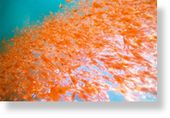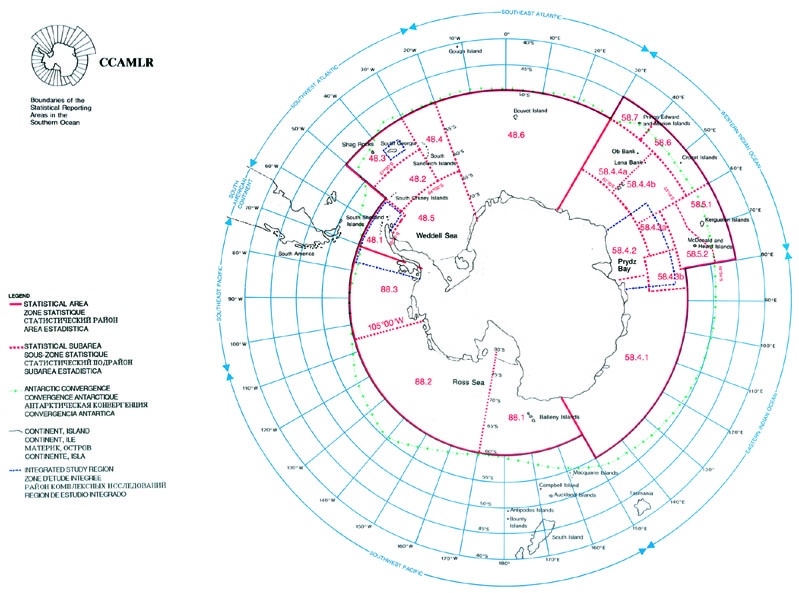Recently there have been a number of unfounded scare tactics stating krill is endangered, and whales are being threatened by krill harvesting. Sites that sell competing sources of omega-3 will reference any type of negative information - such as a more recent article stating that krill oil is banned off the coast of California.
Partial truths like this are shared to confuse the issue. I strongly believe it is appropriate that krill harvesting should be banned in many areas not suitable for harvesting. What these competitors fail to admit is that this localized krill problem in California has nothing to do with the global krill population.
It is only a concern because of commercial fisheries in California that are using the krill to feed their unhealthy salmon fish farms in Oregon and Washington. No one is harvesting krill for humans there.
They also fail to tell you that of the global krill catch, 43% is used for aquaculture feed, 45% is for sport fishing bait and ONLY 12% is used for human consumption. Nearly all of human krill harvesting, including ours, is done in the Antarctic.
Krill is the Largest Biomass in the World
It weighs more than any other population of animals -- or humans, for that matter -- on earth, certainly far more than the fish population from which fish oil is extracted.
There are more krill on the planet than any other creature, and all the evidence points to the fact that krill is in no danger of over harvesting anytime in the near future. In fact, krill harvesting is one of the MOST sustainable practices on the planet.
Krill harvesting is also one of the most carefully regulated, using strict international precautionary catch limit regulations that are reviewed and reassessed regularly to assure sustainability.
Many studies show the biomass of Antarctic krill range anywhere from 170 million to 740 million tons, averaging around 420 million tons, with an annual reproduction rate of several hundred million tons. This ensures a very large standing stock of renewable krill for both natural predators and human use.
From 1990 until today the annual krill harvest is approximately a modest ONE TENTH of one million tons. It should be quite obvious that this is a very small fraction of the total amount of krill in the ocean. There are 4000X more krill than are actually harvested.
But that doesn't mean it's being harvested willy-nilly. No, it's clearly understood that without krill, many of the species in the food chain would quickly perish, so krill harvesting is very strictly regulated for that very reason. And, as you will soon see, the actual harvesting rate is a mere fraction of the precautionary catch limits that have been carefully calculated to assure sustainability.
Commission of 25 Countries Oversee Krill Harvesting
Krill can be found in all oceans, but Antarctic krill is by far the most abundant.
The Antarctic krill biomass is under the management of an international organism of 25 countries called the Commission for the Conservation of Antarctic Marine Living Resources (CCAMLR).
This is the ONLY official and reliable international organism involved in the management of sustainable krill fishery and the monitoring of krill stock, and no shortage of krill has ever been forecasted by CCAMLR.
CCAMLR is viewed as an outstanding framework that is well organized and has developed robust research programs to help ensure successful conservation measures in the Southern Ocean.
They also have the authority to further micromanage, on a season to season basis, to counteract any concerns they may have regarding the strength of the krill population during a particular harvesting season.
Precautionary Approach Ensures Eco-Friendliness
The CCAMLR has implemented a 'precautionary approach' in order to minimize any risks associated with harvesting practices in conditions of uncertainty.
They also use an 'ecosystem approach,' meaning they take into account ecological links between different species and natural variability, such as the natural, cyclical rise and fall in reproduction of a species, for example.
The CCAMLR follows several key principles of conservation:
- Prevention of decrease in the size of any harvested population to levels below those which ensure its stable recruitment. For this purpose its size should not be allowed to fall below a level close to that which ensures the greatest net annual increment
- Maintenance of the ecological relationships between harvested, dependent and related populations of Antarctic marine living resources and the restoration of depleted populations to the levels defined in sub-paragraph (a) above; and
- Prevention of changes or minimization of the risk of changes in the marine ecosystem which are not potentially reversible over two or three decades, taking into account the state of available knowledge of the direct and indirect impact of harvesting, the effect of the introduction of alien species, the effects of associated activities on the marine ecosystem and of the effects of environmental changes, with the aim of making possible the sustained conservation of Antarctic marine living resources.
The CCAMLR also organizes the strategic issuing of mandatory krill harvesting licenses as another control measure to promote sustainability, and are proactively combating illegal fishing of all kinds within the Convention Area, to protect the ecosystem.
Precautionary Catch Limits and Actual Harvests
Antarctic krill harvesting began in 1961, with an historical peak harvest of just under 529,000 tons for the 1981/82 season. However, the mean annual catch rate has dropped significantly since then. Less than 120,000 tons a year (mean) was harvested between 2002 and 2007.
Meanwhile, the precautionary catch limit for 2008 set by the CCAMLR, based on recent surveys of krill stock, was 6.6 million tons.
Only about two percent of the precautionary catch limit has ever been harvested in any given year. This is an extraordinarily low number so let me state it another way. Krill harvesting could increase 50-fold and still be considered safe.
Why Demand for Krill Oil Does Not Constitute an Environmental Threat
Some media sources have accused krill oil consumers of stealing food from the mouths of whales, but with the estimated baleen whale consumption being approximately 85 million tons per year, the actual mean total annual catch equals a mere 0.14 percent of the whales' consumption. If you aren't good with numbers that is LESS than one fifth of one percent!
It's also worth noting that of the total krill harvest each year, almost 88 percent of the catches are used for sport fishing bait and krill meal for fish farms. The rest, 12 percent, is sold for human consumption, with less than 1 percent being processed into krill oil supplements.
So clearly, any statement that krill oil supplements are decimating the food chain is a horrible distortion of the truth.
Eco-Harvesting Strategies Also Help Retain Eco Friendliness of Krill Fishing
Some of the major fishing vessels use superior harvesting technology. Aker BioMarine, who holds two of the four krill harvesting licenses issued in Norway, is one of the leaders in eco-harvesting of krill.
They explain:
"In general it is recognized that about 80-90 percent of the energy is 'lost' going from one level in the ecological value chain to the next level. From this perspective it is hence FAR more efficient the lower in the eco-system the resource is utilized.Aker BioMarine has harvested krill in the Antarctic since 2003, and based on their experience, they've developed a proprietary eco-harvesting technology.
"Krill as a source for food and nutrients is consequently a very energy efficient source from an ecological perspective."
The technology uses a specially designed trawl system with a direct hose connection between the trawl and the vessel, along with a mechanism that singles out unwanted by-catch and releases it back into the water unharmed.
Eco-harvesting causes minimal environmental impact and prevents the krill from enzymatic degradation, allowing for greater preservation of all key nutrients in the end products.
Additionally, Aker BioMarine has taken the proactive approach to maintain a continuous scientific observer from the British Antarctic Survey onboard their fishing vessel.
Besides being involved in research aboard the vessel, the appointed scientist is responsible for observing and reporting daily to CCAMLR on their harvesting. The reporting includes monitoring the catching process, assessing ecological impact (carbon footprint), and the impact on non-target species such as fish larvae.
The summary report after a recent fishing season confirmed that:
- There were no seabird entanglements or observed collisions with the vessel
- No marine mammals were entangled in the fishing gear during the observation period
- Although fur seals were seen all over the net bodies whenever they were close to the surface, there were no observed entanglements with the fishing gear
The WWF has been working actively with CCAMLR for many years, and is also a member of the Antarctic and Southern Ocean Coalition (ASOC) working to protect krill and the other resources in the Southern Ocean.
They're currently working on implementing fine-scale management plans for the krill fishery, which includes implementing ecosystem-based management and applying a highly precautionary approach to managing krill harvesting practices that allows for existing uncertainties, including the impacts of climate change.
The MSC Eco Label Offers Assurance of Sustainable Practices and Traceability
The Marine Stewardship Council (MSC) certification focuses on the health of ocean stocks and how they are managed, in addition to assessing the effect of the fishery on the wider ecosystem. This includes a range of marine mammals, birds and fish.
Companies who have completed the certification can offer yet another layer of assurance to their customers. The MSC eco label provides a guarantee of sustainable fishing practices, as well as full traceability through the chain of custody, from beginning to end.
Why Krill Oil is Your Best Omega-3 Option for DHA and EPA
In my view, krill oil is clearly your best option when it comes to obtaining important high quality animal based omega-3 fats. It contains essential EPA and DHA in a double chain phospholipid structure that makes it far more absorbable than the omega-3s in fish oil.
Krill oil also contains vitamin E, vitamin A, vitamin D and canthaxanthin, which is a potent anti-oxidant. Research has shown the anti-oxidant potency of krill oil is, in terms of ORAC (Oxygen Radical Absorptance Capacity) values, 48 times more potent than fish oil.
And, as opposed to krill, over-fishing IS indeed a reality!
Because rather than following scientists' recommendations and using precautionary approaches to ensure sustainability of fish stocks, fishing agreements and deals have frequently been brokered by politicians, and quotas for fishing fleets are on average 15 to 30 percent higher than those recommended as safe by scientists.
Oftentimes, for less threatened species, the quotas were set 100 percent higher than recommended by environmental scientists.
This is not the case with krill harvesting, which is being assessed and monitored from season to season by qualified scientists and concerned ecological experts from the 25 countries making up the CCAMLR.
So, take your krill oil. Its omega-3's are essential for good health. And it won't harm the environment, or deplete the food chain.
References
HEWITT R.P., J.L. WATKINS, M. NAGANOBU et al., 2002. Setting a precautionary catch limit for Antarctic krill. Oceanography, Volume 15 (3): 26-33. Published by The Oceanography Society, MD, USA.
NICOL S & Y ENDO. 1999. Krill fisheries: Development, management and ecosystem management. Aquatic Living Resources 12 (2): 105-120.
SIEGEL V. 2005. Distribution and population dynamics of Euphausia superba: summary of recent findings. Polar Biol. 29: 1-22.
SMETACEK V. & S. NICOL. 2005. Polar ocean ecosystems in a changing world. Nature 437: 362-368.





Reader Comments
to our Newsletter